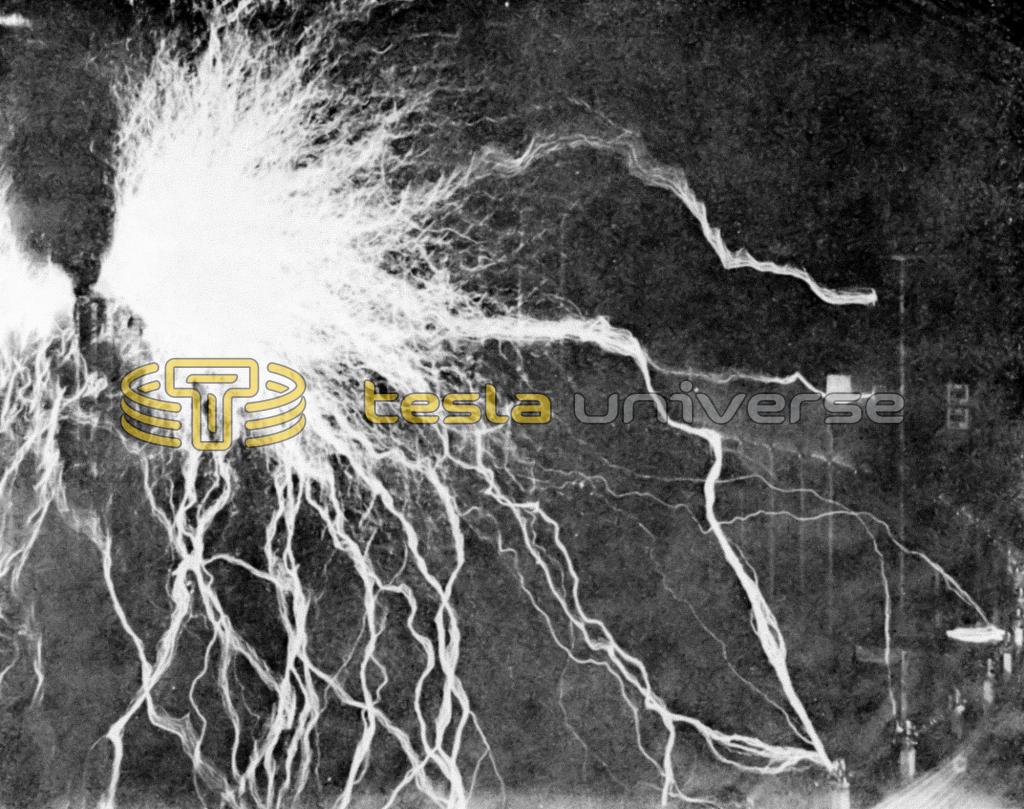
Nikola Tesla Books
Related content from pages
and which was at will adjustable by an adjustment of the wave length of one of the vibrations. The truth is, however, that I observed this phenomenon in vacuum tubes long before without being able to render myself an account of the nature of the same until I obtained the same effect on a wire in the manner stated. Now it is quite clear that, since a streamer is a conducting path comparable to a wire, the same phenomenon may take place on the streamer itself - being the result of two (or possibly more) vibrations of different wave length. This is all the more probable as in such an apparatus two vibrations of this kind may readily occur since the capacity, or the inductance of the circuit or both, may undergo variations as the discharge is playing, thus modifying the period to a slight extent - sufficient to cause the production of this phenomenon. In fact I have frequently observed such variations of the constants of the circuit which is oscillating, these variations being produced in various different ways. Thus it may happen that there is seen on such a long spark or streamer a point or portion of greater or smaller luminosity, or more such points, moving along the path of the discharge with a small velocity, without having anything to do with the occurrence of the fireballs, as before explained.
If the interruption of a discharge in some part of its course, which was noted before, would not have been actually and unmistakably observed, I would think it quite possible that this phenomenon might be due to a dark part or nodal portion formed on the streamer in the manner above set forth, this part being either stationary or slowly shifting along the path of the discharge, as the case may be. I think that I shall be able to settle this point in the following experiment which I propose to carry out. The idea is to provide a streamer which will be preferably straight and will pass continuously through the same path, thus enabling an effect propagated along the streamer to be observed just as on a wire. The streamer should be preferably also of very great length. This I am convinced I can realize as follows:
A glass tube of pieces joined together temporarily, of rather large diameter, and of a length of, say, 30 to 50 feet is to be provided. The end of a well insulated wire, forming the âfreeâ terminal of a coil, as the extra coil here used, is to be led in one end of the glass tube, in the center of the same so that the streamer, when formed on the point of this wire, will have the tendency to pass along the tube on the inside of the same. In order, however, to keep the discharge away from the glass, suction is to be applied on the other end of the tube or else a current of air is to be forced through the tube - from the side of the discharging wire towards the other open end of the former, in any convenient way - so as to compel the streamer to pass along the axis of the glass tube. If the tube is of large diameter I do not think that it will be difficult to carry out the experiment. Now this streamer is to be produced by oscillations of small wave length and under these conditions it will be quite easy to produce stationary or shifting, nodal or maximum points along the path of the streamer.
But, to return to the description of the present photograph, some of the paths described by the discharge are curious in the extreme. Many features dwelt upon before are again and even more clearly shown. So the âsplashingâ, the splitting up and reuniting is plainly visible. Some streamers strike the roof and one particularly was dangerous, the plate showing that after hitting the roof it divided in three parts following the structure. This will scarcely print. An ignition of the roof would have been unavoidable had the switch been held on only a fraction of a second longer. But in manipulating the switch I always took care to throw off the handle instantly when, by chance, one of the discharges

